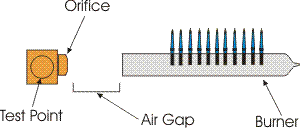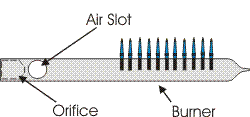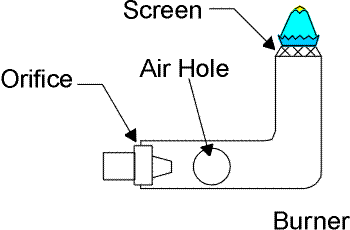Dave's Place
Orifice and Burner
If, after passing through the other components, propane is delivered to the orifice at the correct pressure (11" water column), a good orifice and burner will produce a healthy, correct, blue flame.


The burners shown above are the most common ones today. Propane passes through the small, precise hole of the orifice and jets past the air gap (or air hole) where it picks up air for a proper burn mixture. The propane/air mixture is then released through the slots of the burner where it burns.
Burner
Not much can go wrong with the burner. It has to be clean and undamaged. The slots of the burner need to be intact.
Orifice
The orifice is the very last component in the propane system before the burner, and has a very precise hole
manufactured into it. The orifice and the pressure of the gas passing through it set the size of the burner flame.
If one or the other is incorrect, then the flame will not be correct. Usually, if there is a problem, the orifice
is dirty. Microscopic debris has accumulated around the hole making it smaller and therefore not the correct size.
Also, oil from the propane tank and other propane components can be deposited on the orifice, making it easier for
debris to stick to it.
To clean the orifice, first remove it. Sometimes blowing air through the orifice will clean it, but since you already have it out, you should soak it in alcohol or paint thinner (some non-oily solvent) for a few hours to dissolve any oil build up. And, then blow air through it. Do NOT poke anything into the orifice. It is such a precise hole, that you will either accomplish nothing or you will enlarge it and ruin it. There are no orifice bits for RV refrigerator orifices. In fact, there is no apparent logic in the numbering of orifices between manufacturers. A Dometic #58 orifice is roughly equivalent to a Norcold .16 orifice. Sometimes, even after repeated cleanings of the orifice, the flame is still not right and in your heart you feel everything else is right. This is possible. Sometimes an orifice seems to be uncleanable or can be defective. If you can, replace the orifice. If you can't replace the orifice -- keep cleaning. One important thing to note is that if you enlarge the orifice, you will increase the heat output of the flame and ruin the cooling unit Another, rarer problem on metal orifices is that the flow of propane over the years can actually erode the orifice and either make it out of round or enlarge it. In the either case, the orifice has to be replaced.
Other times, you may be in a situation where you can't remove the orifice without damaging it In such a situation, you can attempt to clean it by blowing air through it while it is in place. Do this only from the back side of the orifice and blow towards the burner. If air pressure (which can easily be more than 100 times the pressure of regulated propane) is blown back through the other components of the propane system, they will be damaged.

Many later model refrigerators have a ruby orifice. This is a brass fitting much like any other orifice, except that it has a manufactured ruby embedded into the end of it. The ruby has been precisely laser cut to the correct size. Also, the cut has a jagged edge to give the propane a little twirl as it leaves the orifice. See graphic above. Erosion will not occur on this orifice and you also will not be able to enlarge it by sticking an object through it. You can't enlarge it, but you can break it. If they become dirty, clean as in the section above. Some replacement orifices for older model refrigerators are ruby orifices.
Older Burners See figure below)
Like the burners above, propane passes through the small, precise hole of the orifice and jets pass the air hole
where it picks up air for a proper burn mixture. There are a few variations on the air hole. Sometimes the orifice
is set back from the burner, allowing the propane to pick up air before it enters the burner. Some older burners
have adjustment rings around the air hole for fine tuning the burner. The propane/air mixture is released through
the screen at the end of the burner where it burns. The screen needs to be intact.

RV Refrigerator Home
This RV refridgerator information was originally located on rvmobile.comRV Mobile Inc. 11715 HWY 99, Everett, WA 98204
The owner of RV Mobile Inc. apparently suffered a heart attack and the original website was shut down.
It has been reposted here to preserve this wealth of information RV refridgerator information.